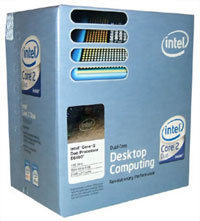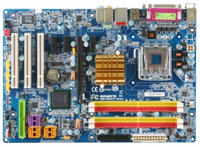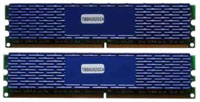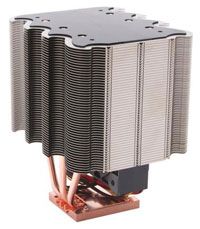Midrange Overclocking Configuration
The final category we have to talk about involves everyone's favorite topic: overclocking. We have shown in
recent articles that certain CPUs can outperform processors that cost six times as much once you add in overclocking. A lot of people also like the thought of getting "something for nothing," so we will conclude this Buyer's Guide with some upgrades intended to help you get the most out of your overclocking endeavors.
| Intel Mid-Range Overclocking System |
| Hardware |
Component |
Price |
Rebates |
| Processor |
Intel Core 2 Duo E6400 (2.13GHz 2MB Shared) - Retail |
$223 |
|
| Heatsink |
Tuniq Tower 120 |
$55 |
|
| Motherboard |
Gigabyte GA-965P-DS3 (P965 775) |
$138 |
|
| Memory |
Super Talent 2x1GB DDR2-800 (T800UX2GC4) |
$268 |
|
| Video Card |
eVGA GeForce 7600GT 256MB (256-P2-N550 -T2) |
$131 |
|
| Hard Drive |
Seagate 320GB SATA 3.0Gbps 7200RPM 16MB (Barracuda 7200.10) |
$90 |
|
| Optical Drive |
LG Black 18X DVD+R (GSAH22N-BK) |
$36 |
|
| Case |
Antec Solution SLK3000-B |
$76 |
|
| Power Supply |
OCZ GameXStream 700W (OCZ700GXSSLI) |
137 |
|
| Display |
Acer AL2016W 20" 8ms (1680x1050) |
$233 |
|
| Speakers |
Logitech X-530 5.1 70W Speakers |
$74 |
|
| Keyboard and Mouse |
Microsoft Comfort Curve 2000 B2L-00047 |
$28 |
|
| Operating System |
Windows XP MCE 2005 (with Vista coupon) |
$115 |
|
| Bottom Line |
|
$1604 |
$1604 |
 |
So far in this guide, AMD platforms have been a reasonable alternative to Intel's Core 2 Duo platform. They may not be faster in many cases, but at the lower end of the dual core spectrum the price/performance is nearly identical when comparing Athlon X2 and Core 2 Duo. Once you add in overclocking, however, there's no way that we would currently recommend AMD over Intel. There are still some AMD chips that can achieve impressive overclocks - one of our editors for instance is running an Athlon X2 4000+ (2.0GHz 1MB cache stock) at 3.08 GHz - but with many Core 2 Duo overclocks reaching 3.5 GHz and higher AMD is not currently able to match that level of performance, short of resorting to phase change cooling.
 |
Besides the processor, there are several critical components that can help increase overclocking potential as well as providing improved stability. First of course is the motherboard, which almost goes without saying. A great chipset alone can't provide for excellent overclocking, and at the same time the world's best BIOS programmers can't overcome chipset limitations. When you get a great chipset with an excellent motherboard design and the proper BIOS, however, the results can be extremely impressive. There are motherboards that overclock better than Gigabyte's GA-965P-DS3, but with the latest BIOS update and the price of under $150 it is very difficult to beat the DS3. The ASUS P5B-E we mentioned previously is a close second; the DS3 costs a bit less and overclocks a bit further, while the ASUS has a few more features.
 |
Next on the upgrade requirements for overclocking has to be memory. You can get some very respectable overclocks using just about any DDR2-800 memory, but if you want to push into the 500MHz bus speed overclocks and beyond, you'll need memory that can function at DDR2-1000 and higher. As this is a midrange guide, we didn't want to go to extreme on the memory side of things, but the Super Talent memory we mentioned previously can easily reach DDR2-1000 at 2.2V and we feel that's sufficient given our other components. Using a 1:1 memory:bus ratio (which is typically optimal for overclocking), DDR2-1000 means you can run a 500MHz bus. You may have noticed that we didn't select an E6300 processor, and the reason is that we don't want the RAM and bus speed to be the limiting factors. An E6300 with a 500MHz bus would be running at 3.5 GHz, and while that's certainly an impressive overclock we prefer the 8X multiplier of the E6400. It is doubtful that you will be able to run most E6400 chips at 4.0GHz, but hitting somewhere around 3.6-3.7 GHz isn't uncommon.
 |
The last two items that are important when looking at maximum overclocking are CPU/system cooling and the power supply. The stock Intel heatsink performs quite well, but it's still not able to match the cooling prowess of the better aftermarket solutions. As we showed in our recent article, the
Tuniq Tower 120 was able to dramatically lower processor temperatures, and it also improved overclocking headroom by about 200MHz. It manages to do this without generating a lot of noise, and for a cost of about $60 it provides a far better long-term overclocking solution than the stock heatsink. In order to overclock most CPUs beyond a certain point, it is necessary to increase the processor voltage. This in turn increases the heat generated by the CPU, so adequate cooling becomes even more critical. Large aftermarket heatsinks like the Tuniq Tower 120 may be a bit more difficult to install, but they are still highly recommended for anyone looking to push their CPU to the limit.
 |
Increasing processor and memory voltages naturally puts a larger strain on the power supply. Several of the other editors have burned through quite a few power supplies during overclocking attempts, especially at the more extreme end of the equation. When we looked at upgrading the power supply to something that would be suitable for intense overclocking, we found that most of the 500W to 600W power supplies really didn't cost much less than the 700W PSU that we selected. The Fortron Source FX700-GLN is essentially the same power supply as the OCZ GameXStream 700W, and it's priced about the same. However, the Fortron Source comes with a two-year warranty while OCZ has a three-year warranty, so the choice is pretty clear.
We stuck with a pretty average GPU on our overclocking system - faster than the base 7600GS, but a 7600GT is by no means a graphics powerhouse these days. NVIDIA cards typically overclock better than AMD offerings, but the 7600GT is already factory overclocked and probably can't get much faster. If you want to get a high-performance GPU with more overclocking headroom, the GeForce 8800 GTS cards appear to be the best bet right now. They're already fast at stock speeds, but overclocking has helped quite a few people reach near 8800 GTX performance levels at 2/3 the cost. As always, your mileage may vary, and we would tend to be a bit more cautious with overclocking GPUs as opposed to CPUs.
So what's the bottom line when it comes to overclocking? For about $300 more, you can most likely get a Core 2 Duo E6400 to run twice as fast as the stock E6300. Individual results will of course vary, as no two processors are identical, but we are reasonably confident that knowledgeable overclockers will be able to hit 3.6 GHz or more with this particular configuration. If you wanted to stick with the basic Intel configuration we listed and simply overclock that, you could probably hit 2.8 GHz before running into the limitations of the memory and motherboard, but you would also end up with a processor that was running somewhat warm. Before you go out and jump on the configuration we just listed, however, keep in mind that the Core 2 Duo E4300 will be available shortly with a lower price, and with the lower base front side bus speed and a 9X multiplier it should be able to reach 9x400 (3.6 GHz) simply by adding a better aftermarket heatsink.
Conclusion
We've covered no less than five potential system builds in this Midrange Buyer's Guide, and still we haven't covered every possibility. However, with the information we've provided, you should now have enough information to get started building your own ideal midrange computer. As always, comments and questions are welcome. There are always new products launching, and some of those will surpass the components we have selected here, but for now these component choices offer some of the best bang for the buck on the market.















43 Comments
View All Comments
vailr - Friday, January 19, 2007 - link
Intel doesn't offer any compelling single core solutions right now.Consider the socket 775 Celeron D 356. When compared with an older Northwood P4 CPU of similar speed [~3.3 GHz at stock speed], it would seem to be a very good price/performance ratio upgrade. Tiger Direct has it for $50, after a $20 MIR. Combine with a VIA chip based motherboard, such as the ASRock Dual-VSTA or ECS P4M800 (or similar VIA board), which can also still re-use older DDR memory sticks and AGP video cards. Might even make an interesting basis for an Anandtech review, showing the "best bang for buck" upgrades, for a 2 or 3 year old system.
Some Celeron D 356 owners have also had excellent overclocking results (past 4 GHz), depending on the motherboard used.
mino - Saturday, January 20, 2007 - link
When compared with an older Northwood P4 CPUWell, the problem is A64 3200+ goes for $60.
$5 cheaper than 356...
LoneWolf15 - Friday, January 19, 2007 - link
At which resolutions? At 1920x1200, I think the 8800GTS would be the clear winner.
Also, I'd be interested to know how much difference there is between the Creative X-Fi ExtremeGamer, and the similarly priced (well, compared to your review, online I've seen it retailing slightly higher) X-Fi ExtremeAudio. The ExtremeAudio has the nicer gold-plated jacks; the ExtremeGamer actually is the first Creative card that I've seen that allows a user to plug in standard Intel-spec front panel audio. The card layouts are so different that I'm sure there has to be more differences than that; I'd like to know what those are.
uofahoefx - Friday, January 19, 2007 - link
If you are comparing price/performance I think the X2 4200+ would have been a better starting point. The performance difference between the 3800+ and E6300 is too significant to compare these systems.KorruptioN - Friday, January 19, 2007 - link
Whether or not the Rosewill 600W is really that much better than the Fotron Source 450W is debatableIt really is. I did some research as to who really was the OEM for this particular 600W Rosewill, and it turns out that the OEM is Solytech (the UL label on the PSU says E223918, Googling that brings me to http://www.jonnyguru.com/SMPS_UL.htm">this list, which then tells me Solytech). These guys are the new image for Deer electronics. If you've been around the hardware world for a while, you might know that Deer PSUs a few years back were notorious for being fire hazards, nothing better than doorstops. I still wouldn't trust them today. I think it was a poor choice for your guide.
For $71, you can get a much better PSU. Antec's http://www.newegg.com/Product/Product.asp?Item=N82...">TP3-430 is a good choice, and you'd be saving money. It's a Seasonic build, so you can be assured of high-efficiency, low-noise, and good power.
Operandi - Friday, January 19, 2007 - link
Your right Rosewill sucks. This guide would have been better served having recommended the entry level 450 watt Forton across the board since nothing here would be able to break 300 watts DC let alone 600 (assuming the Rosewill could even reach that point which itself is doubtful).About the Antec TP3; it is built buy Seasonic but it has also had corners cut to reach that price point -- it is not equal to Seasonic's own units. If you want Seasonic build quality get a Seasonic (or PCP&C Silencer or Crucial) if you want the best PSU to $$$ ratio it has to be this 400 watt http://www.ewiz.com/detail.php?name=PS-E5140GH">Enhance.
JarredWalton - Friday, January 19, 2007 - link
Despite the hard stance a lot of "informed enthusiasts" take on Rosewill, actual testing of a 500W unit by http://www.jonnyguru.com/review_details.php?id=48">JohnnyGuru.com turned in very favorable results. This is the same site that disliked the high ripple on the OCZ GameXStream 700W, FWIW (but still gave it a good review). I continue to think people are judging Rosewill without having actually tested/used any of their products. Are their QC standards as high as SeaSonic or some of the other top brands? Probably not, but outside of perhaps higher than normal DOA parts (which you just send back and get a new, working unit), they work very well in our experience.yyrkoon - Sunday, January 21, 2007 - link
Now, it is not the one being talked about here, but just yesterday, another IT friend of mine, got in his new thermaltake water cooled system case, and used a 350W Rosewill PSU to power up the water cooling portion (thankfully for him, his system board hadn't arrived yet), and while testing the cooling system a loud *pop* came from the the PSU, followed by a small 'billow' of smoke( he thinks he probably blew the top of a capacitor off, but didn't bother to look). The PSU continued to work for another 15 minutes according to him, but who knows what would have happened if this was powering a full system.Yeah, a 350W PSU, would not be powering an i680 system board, with a E6600, and dual 8800GTX's (which will be his finished system), but this speaks a lot for the manufacturer IMHO. Also, I've rarely seen a PSU take out more than just itself when dying, but it does happen. In my buddies case here, he intends on this system lasting him another 4-5 years, so, having an in-expencive PSU in the mix is not an option. One last thing, JonnyGuru mentions himself, that even while the Rosewill PSU in question does perform admirably, the choice of capacitors use in it, is questionable. Anyone who has been building systems for a awhile must realize that when components die in a computer system, there is a very good chance, it is because of the caps used on one component, or another, be it system board, or PSU. I myself am a big fan of ABIT, and even have had a system board from them die after 5-6 years, because of leaking / bad caps . . .
mostlyprudent - Saturday, January 20, 2007 - link
I have been personally very disappointed with my Rosewill PSU. I bought a 400W version about a year ago to replace the generic 350W that came with the case I used for the general family PC. The Rosewill is louder and less stable. I had recently bought an Fortron Source 380W for my office PC for a few $ more than the Rosewill and have been extremely pleased.Just thought I'd share my personal experience for what it is worth.
yyrkoon - Friday, January 19, 2007 - link
DO you seriously think any reseller / system integrator would recommend such a PSU ? I wouldn't. Anyone can make sly connotations one way, or another, but the simple fact is, we here have a reputation to uphold when building systems for 2nd parties, and would NEVER recommend such a PSU. Now if a customers wishes to shave costs by buying 'lesser' components, we just make sure they're informed of the possibilities, and leave it at that. It is not like every single 'cheap' PSU is garbage, most work fine, it is the ones you don't know about that creep up and bite you in the ass.
Another way to look at it is, you just dropped $1000 on a system, that will hopefully last at least a couple of years, whats another $100-$200 on a good, proven PSU? Perhaps if your computer means very little to *you* there is no harm done, when and if if fails, but I personally like the assurance that whatever I buy will be the best for the amount of money I've spent, and simply put, none of those parts would be made by Rosewill. An external USB HDD case ? sure, ok, fine, but never a PSU.